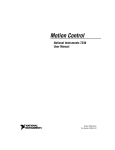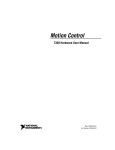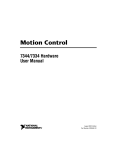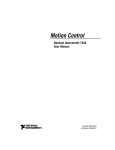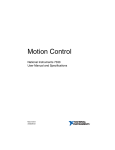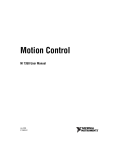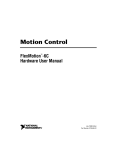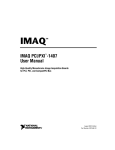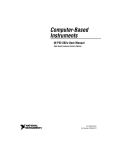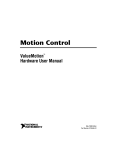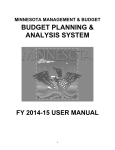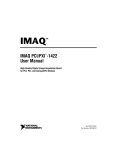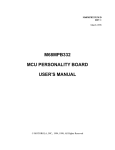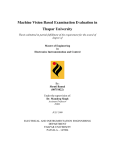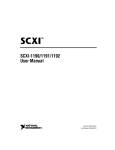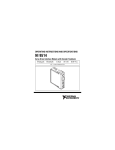Download Motion Control NI PCI-7342 Hardware User Manual
Transcript
Motion Control NI PCI-7342 Hardware User Manual NI PCI-7342 Hardware User Manual October 2002 Edition Part Number 373454A-01 Support Worldwide Technical Support and Product Information ni.com National Instruments Corporate Headquarters 11500 North Mopac Expressway Austin, Texas 78759-3504 USA Tel: 512 683 0100 Worldwide Offices Australia 03 9879 5166, Austria 0662 45 79 90 0, Belgium 02 757 00 20, Brazil 55 11 3262 3599, Canada (Calgary) 403 274 9391, Canada (Montreal) 514 288 5722, Canada (Ottawa) 613 233 5949, Canada (Québec) 514 694 8521, Canada (Toronto) 905 785 0085, China 86 21 6555 7838, Czech Republic 02 2423 5774, Denmark 45 76 26 00, Finland 09 725 725 11, France 01 48 14 24 24, Germany 089 741 31 30, Greece 01 42 96 427, Hong Kong 2645 3186, India 91 80 4190000, Israel 03 6393737, Italy 02 413091, Japan 03 5472 2970, Korea 02 3451 3400, Malaysia 603 9596711, Mexico 001 800 010 0793, Netherlands 0348 433466, New Zealand 09 914 0488, Norway 32 27 73 00, Poland 22 3390 150, Portugal 210 311 210, Russia 095 238 7139, Singapore 65 6 226 5886, Slovenia 3 425 4200, South Africa 11 805 8197, Spain 91 640 0085, Sweden 08 587 895 00, Switzerland 056 200 51 51, Taiwan 02 2528 7227, United Kingdom 01635 523545 For further support information, refer to the Technical Support and Professional Services appendix. To comment on the documentation, send email to [email protected]. © 2002 National Instruments Corporation. All rights reserved. Important Information Warranty The NI PCI-7342 controller is warranted against defects in materials and workmanship for a period of one year from the date of shipment, as evidenced by receipts or other documentation. National Instruments will, at its option, repair or replace equipment that proves to be defective during the warranty period. This warranty includes parts and labor. The media on which you receive National Instruments software are warranted not to fail to execute programming instructions, due to defects in materials and workmanship, for a period of 90 days from date of shipment, as evidenced by receipts or other documentation. National Instruments will, at its option, repair or replace software media that do not execute programming instructions if National Instruments receives notice of such defects during the warranty period. National Instruments does not warrant that the operation of the software shall be uninterrupted or error free. A Return Material Authorization (RMA) number must be obtained from the factory and clearly marked on the outside of the package before any equipment will be accepted for warranty work. National Instruments will pay the shipping costs of returning to the owner parts which are covered by warranty. National Instruments believes that the information in this document is accurate. The document has been carefully reviewed for technical accuracy. In the event that technical or typographical errors exist, National Instruments reserves the right to make changes to subsequent editions of this document without prior notice to holders of this edition. The reader should consult National Instruments if errors are suspected. In no event shall National Instruments be liable for any damages arising out of or related to this document or the information contained in it. EXCEPT AS SPECIFIED HEREIN, NATIONAL INSTRUMENTS MAKES NO WARRANTIES, EXPRESS OR IMPLIED, AND SPECIFICALLY DISCLAIMS ANY WARRANTY OF MERCHANTABILITY OR FITNESS FOR A PARTICULAR PURPOSE. CUSTOMER’S RIGHT TO RECOVER DAMAGES CAUSED BY FAULT OR NEGLIGENCE ON THE PART OF NATIONAL INSTRUMENTS SHALL BE LIMITED TO THE AMOUNT THERETOFORE PAID BY THE CUSTOMER. NATIONAL INSTRUMENTS WILL NOT BE LIABLE FOR DAMAGES RESULTING FROM LOSS OF DATA, PROFITS, USE OF PRODUCTS, OR INCIDENTAL OR CONSEQUENTIAL DAMAGES, EVEN IF ADVISED OF THE POSSIBILITY THEREOF. This limitation of the liability of National Instruments will apply regardless of the form of action, whether in contract or tort, including negligence. Any action against National Instruments must be brought within one year after the cause of action accrues. National Instruments shall not be liable for any delay in performance due to causes beyond its reasonable control. The warranty provided herein does not cover damages, defects, malfunctions, or service failures caused by owner’s failure to follow the National Instruments installation, operation, or maintenance instructions; owner’s modification of the product; owner’s abuse, misuse, or negligent acts; and power failure or surges, fire, flood, accident, actions of third parties, or other events outside reasonable control. Copyright Under the copyright laws, this publication may not be reproduced or transmitted in any form, electronic or mechanical, including photocopying, recording, storing in an information retrieval system, or translating, in whole or in part, without the prior written consent of National Instruments Corporation. Trademarks CVI™, LabVIEW™, National Instruments™, NI™, ni.com™, NI-Motion™, and RTSI™ are trademarks of National Instruments Corporation. Product and company names mentioned herein are trademarks or trade names of their respective companies. WARNING REGARDING USE OF NATIONAL INSTRUMENTS PRODUCTS (1) NATIONAL INSTRUMENTS PRODUCTS ARE NOT DESIGNED WITH COMPONENTS AND TESTING FOR A LEVEL OF RELIABILITY SUITABLE FOR USE IN OR IN CONNECTION WITH SURGICAL IMPLANTS OR AS CRITICAL COMPONENTS IN ANY LIFE SUPPORT SYSTEMS WHOSE FAILURE TO PERFORM CAN REASONABLY BE EXPECTED TO CAUSE SIGNIFICANT INJURY TO A HUMAN. (2) IN ANY APPLICATION, INCLUDING THE ABOVE, RELIABILITY OF OPERATION OF THE SOFTWARE PRODUCTS CAN BE IMPAIRED BY ADVERSE FACTORS, INCLUDING BUT NOT LIMITED TO FLUCTUATIONS IN ELECTRICAL POWER SUPPLY, COMPUTER HARDWARE MALFUNCTIONS, COMPUTER OPERATING SYSTEM SOFTWARE FITNESS, FITNESS OF COMPILERS AND DEVELOPMENT SOFTWARE USED TO DEVELOP AN APPLICATION, INSTALLATION ERRORS, SOFTWARE AND HARDWARE COMPATIBILITY PROBLEMS, MALFUNCTIONS OR FAILURES OF ELECTRONIC MONITORING OR CONTROL DEVICES, TRANSIENT FAILURES OF ELECTRONIC SYSTEMS (HARDWARE AND/OR SOFTWARE), UNANTICIPATED USES OR MISUSES, OR ERRORS ON THE PART OF THE USER OR APPLICATIONS DESIGNER (ADVERSE FACTORS SUCH AS THESE ARE HEREAFTER COLLECTIVELY TERMED “SYSTEM FAILURES”). ANY APPLICATION WHERE A SYSTEM FAILURE WOULD CREATE A RISK OF HARM TO PROPERTY OR PERSONS (INCLUDING THE RISK OF BODILY INJURY AND DEATH) SHOULD NOT BE RELIANT SOLELY UPON ONE FORM OF ELECTRONIC SYSTEM DUE TO THE RISK OF SYSTEM FAILURE. TO AVOID DAMAGE, INJURY, OR DEATH, THE USER OR APPLICATION DESIGNER MUST TAKE REASONABLY PRUDENT STEPS TO PROTECT AGAINST SYSTEM FAILURES, INCLUDING BUT NOT LIMITED TO BACK-UP OR SHUT DOWN MECHANISMS. BECAUSE EACH END-USER SYSTEM IS CUSTOMIZED AND DIFFERS FROM NATIONAL INSTRUMENTS' TESTING PLATFORMS AND BECAUSE A USER OR APPLICATION DESIGNER MAY USE NATIONAL INSTRUMENTS PRODUCTS IN COMBINATION WITH OTHER PRODUCTS IN A MANNER NOT EVALUATED OR CONTEMPLATED BY NATIONAL INSTRUMENTS, THE USER OR APPLICATION DESIGNER IS ULTIMATELY RESPONSIBLE FOR VERIFYING AND VALIDATING THE SUITABILITY OF NATIONAL INSTRUMENTS PRODUCTS WHENEVER NATIONAL INSTRUMENTS PRODUCTS ARE INCORPORATED IN A SYSTEM OR APPLICATION, INCLUDING, WITHOUT LIMITATION, THE APPROPRIATE DESIGN, PROCESS AND SAFETY LEVEL OF SUCH SYSTEM OR APPLICATION. Compliance FCC/Canada Radio Frequency Interference Compliance Determining FCC Class The Federal Communications Commission (FCC) has rules to protect wireless communications from interference. The FCC places digital electronics into two classes. These classes are known as Class A (for use in industrial-commercial locations only) or Class B (for use in residential or commercial locations). Depending on where it is operated, this product could be subject to restrictions in the FCC rules. (In Canada, the Department of Communications (DOC), of Industry Canada, regulates wireless interference in much the same way.) Digital electronics emit weak signals during normal operation that can affect radio, television, or other wireless products. By examining the product you purchased, you can determine the FCC Class and therefore which of the two FCC/DOC Warnings apply in the following sections. (Some products may not be labeled at all for FCC; if so, the reader should then assume these are Class A devices.) FCC Class A products only display a simple warning statement of one paragraph in length regarding interference and undesired operation. Most of our products are FCC Class A. The FCC rules have restrictions regarding the locations where FCC Class A products can be operated. FCC Class B products display either a FCC ID code, starting with the letters EXN, or the FCC Class B compliance mark that appears as shown here on the right. Consult the FCC Web site at http://www.fcc.gov for more information. FCC/DOC Warnings This equipment generates and uses radio frequency energy and, if not installed and used in strict accordance with the instructions in this manual and the CE Marking Declaration of Conformity*, may cause interference to radio and television reception. Classification requirements are the same for the Federal Communications Commission (FCC) and the Canadian Department of Communications (DOC). Changes or modifications not expressly approved by National Instruments could void the user’s authority to operate the equipment under the FCC Rules. Class A Federal Communications Commission This equipment has been tested and found to comply with the limits for a Class A digital device, pursuant to part 15 of the FCC Rules. These limits are designed to provide reasonable protection against harmful interference when the equipment is operated in a commercial environment. This equipment generates, uses, and can radiate radio frequency energy and, if not installed and used in accordance with the instruction manual, may cause harmful interference to radio communications. Operation of this equipment in a residential area is likely to cause harmful interference in which case the user will be required to correct the interference at his own expense. Canadian Department of Communications This Class A digital apparatus meets all requirements of the Canadian Interference-Causing Equipment Regulations. Cet appareil numérique de la classe A respecte toutes les exigences du Règlement sur le matériel brouilleur du Canada. Class B Federal Communications Commission This equipment has been tested and found to comply with the limits for a Class B digital device, pursuant to part 15 of the FCC Rules. These limits are designed to provide reasonable protection against harmful interference in a residential installation. This equipment generates, uses, and can radiate radio frequency energy and, if not installed and used in accordance with the instructions, may cause harmful interference to radio communications. However, there is no guarantee that interference will not occur in a particular installation. If this equipment does cause harmful interference to radio or television reception, which can be determined by turning the equipment off and on, the user is encouraged to try to correct the interference by one or more of the following measures: • Reorient or relocate the receiving antenna. • Increase the separation between the equipment and receiver. • Connect the equipment into an outlet on a circuit different from that to which the receiver is connected. • Consult the dealer or an experienced radio/TV technician for help. Canadian Department of Communications This Class B digital apparatus meets all requirements of the Canadian Interference-Causing Equipment Regulations. Cet appareil numérique de la classe B respecte toutes les exigences du Règlement sur le matériel brouilleur du Canada. Compliance to EU Directives Readers in the European Union (EU) must refer to the Manufacturer’s Declaration of Conformity (DoC) for information* pertaining to the CE Marking compliance scheme. The Manufacturer includes a DoC for most every hardware product except for those bought for OEMs, if also available from an original manufacturer that also markets in the EU, or where compliance is not required as for electrically benign apparatus or cables. To obtain the DoC for this product, click Declaration of Conformity at ni.com/hardref.nsf/. This Web site lists the DoCs by product family. Select the appropriate product family, followed by your product, and a link to the DoC appears in Adobe Acrobat format. Click the Acrobat icon to download or read the DoC. * The CE Marking Declaration of Conformity will contain important supplementary information and instructions for the user or installer. Contents About This Manual Conventions ...................................................................................................................ix Related Documentation..................................................................................................x Chapter 1 Introduction About the NI PCI-7342..................................................................................................1-1 Hardware .........................................................................................................1-1 RTSI ................................................................................................................1-1 PCI-7342 Features ...........................................................................................1-2 Servo and Stepper Fundamentals ....................................................................1-2 Getting Started ...............................................................................................................1-3 Software Programming Choices ....................................................................................1-3 National Instruments Application Software ..................................................................1-3 Optional Equipment .......................................................................................................1-4 Motion I/O Connections ................................................................................................1-4 Chapter 2 Configuration and Installation Software Installation ......................................................................................................2-1 Controller Configuration................................................................................................2-1 Unpacking ......................................................................................................................2-1 Safety Information .........................................................................................................2-2 Hardware Installation.....................................................................................................2-4 Chapter 3 Hardware Overview User Connectors.............................................................................................................3-2 Chapter 4 Functional Overview Dual Processor Architecture ..........................................................................................4-1 Embedded Real-Time Operating System (RTOS) ..........................................4-2 Trajectory Generators......................................................................................4-2 Analog Feedback .............................................................................................4-2 Flash Memory..................................................................................................4-3 © National Instruments Corporation vii NI PCI-7342 Hardware User Manual Contents Axes and Motion Resources.......................................................................................... 4-3 Axes ................................................................................................................ 4-3 Motion Resources ........................................................................................... 4-4 Host Communications ................................................................................................... 4-5 Chapter 5 Signal Connections Motion I/O Connector ................................................................................................... 5-2 Motion Axis Signals........................................................................................ 5-5 Limit and Home Inputs ................................................................................... 5-6 Wiring Concerns............................................................................... 5-7 Limit and Home Input Circuit .......................................................... 5-7 Encoder Signals............................................................................................... 5-8 Encoder <1..2> Phase A/Phase B ..................................................... 5-8 Encoder <1..2> Index ....................................................................... 5-9 Wiring Concerns............................................................................... 5-10 Encoder Input Circuit ....................................................................... 5-11 Trigger Inputs, Shutdown Input, and Breakpoint Outputs ............... 5-11 Wiring Concerns............................................................................... 5-12 Trigger Input, Shutdown Input, and Breakpoint Output Circuits..... 5-12 Analog Inputs.................................................................................................. 5-13 Wiring Concerns............................................................................... 5-15 Other Motion I/O Connection ......................................................................... 5-15 Digital I/O Connector .................................................................................................... 5-16 PWM Features................................................................................................. 5-17 RTSI Connector............................................................................................................. 5-17 RTSI Signal Considerations............................................................................ 5-17 Appendix A Specifications Appendix B Cable Connector Descriptions Appendix C Technical Support and Professional Services Glossary Index NI PCI-7342 Hardware User Manual viii ni.com About This Manual This manual provides guidelines for programming and operating the National Instruments PCI-7342 motion controller and includes controller specifications and descriptions of electrical and mechanical features. Refer to the Glossary for definitions of selected related terms. Conventions The manual uses the following conventions: <> Angle brackets that contain numbers separated by an ellipsis represent a range of values associated with a bit or signal name—for example, DBIO<3..0>. This icon denotes a note, which alerts you to important information. This icon denotes a caution, which advises you of precautions to take to avoid injury, data loss, or a system crash. bold Bold text denotes items that you must select or click in the software, such as menu items and dialog box options. Bold text also denotes parameter names. italic Italic text denotes variables, emphasis, a cross reference, or an introduction to a key concept. This font also denotes text that is a placeholder for a word or value that you must supply. monospace Text in this font denotes text or characters that you should enter from the keyboard, sections of code, programming examples, and syntax examples. This font is also used for the proper names of disk drives, paths, directories, programs, subprograms, subroutines, device names, functions, operations, variables, filenames and extensions, and code excerpts. © National Instruments Corporation ix NI PCI-7342 Hardware User Manual About This Manual Related Documentation The following documents contain information pertaining to the PCI-7342 motion controller: • NI-Motion Release Notes • NI-Motion Software Reference Manual • NI-Motion Software Reference online help • NI-Motion VIs online help • PCI Local Bus Specification, Revision 2.1 • Your computer’s technical reference manual NI PCI-7342 Hardware User Manual x ni.com 1 Introduction This chapter describes the features and functionality of the National Instruments PCI-7342 motion controller. It includes a list of items necessary for getting started with your controller, software choices, and optional equipment. About the NI PCI-7342 The NI PCI-7342 motion controller features advanced motion control with easy-to-use software tools and add-on motion VI libraries for use with LabVIEW. The PCI-7342 controller provides dedicated motion I/O for limit and home switches and additional I/O for general-purpose functions. The following sections describe the features of the PCI-7342. Hardware The PCI-7342 controller has high-performance capabilities because of the advanced dual-processor architecture that uses a Motorola MC68331 real-time 32-bit CPU, combined with an Analog Devices ADSP-2185 digital signal processor (DSP) and custom field programmable gate arrays (FPGAs). The first-in-first-out (FIFO) bus interface and powerful function set provide high-speed communications while offloading complex motion functions from the host PC for optimum command throughput and system performance. Each axis has motion I/O for end-of-travel limit and home switch inputs, breakpoint output, trigger input, and encoder feedback rates up to 20 MHz. The PCI-7342 controller also has nondedicated user I/O, including 32 bits of digital I/O and two analog inputs for ±10 V signals, joystick inputs, or monitoring of analog sensors. Additionally, the analog inputs can provide feedback for loop closure. RTSI The PCI-7342 controller supports the National Instruments Real-Time System Integration (RTSI) bus. RTSI is a dedicated, high-speed digital bus that facilitates low-level, high-speed, real-time communication between © National Instruments Corporation 1-1 NI PCI-7342 Hardware User Manual Chapter 1 Introduction National Instruments devices. The RTSI bus provides high-speed connectivity between National Instruments products, including image acquisition (IMAQ) and data acquisition (DAQ) devices. With RTSI, you can easily synchronize several functions to a common trigger or timing event across multiple motion, IMAQ, and DAQ devices. RTSI requires no external cabling and does not consume host bus bandwidth. Additionally, the RTSI bus features built-in switching that you can control with software to route signals to and from the bus on the fly. The bus interface on PCI devices is an internal 34-pin connector. Signals are shared through a ribbon cable inside the PC enclosure. RTSI cables are available for chaining two, three, four, or five devices together. Seven of the 34 pins on the RTSI connector are available for user signals. You can use the software-configurable RTSI switch to accommodate more than seven signal options for each device. With this many-to-few selector switch, any available signal can be routed to any RTSI pin. You can also route more than one signal to a single RTSI pin or connect two RTSI pins to the same signal. Note Refer to the National Instruments Developer Zone at ni.com/zone for more information about RTSI, including tutorials, examples, and configuration guidelines. PCI-7342 Features The PCI-7342 controller combines servo and stepper functionality for PCI bus computers. It provides motion control for up to two independent or coordinated axes of motion. You can use the PCI-7342 motion controller for point-to-point and straight-line vector moves for stepper and servo motor applications. Servo and Stepper Fundamentals Servo axes can control servo motors, servo hydraulics, servo valves, and other servo devices. Servo axes always operate in closed-loop mode. These axes use quadrature encoders or analog inputs for position and velocity feedback and provide analog command outputs with an industry-standard range of ±10 V. Stepper axes control stepper motors and operate in open- or closed-loop mode. They use quadrature encoders or analog inputs for position and velocity feedback (closed-loop only), and provide step/direction or NI PCI-7342 Hardware User Manual 1-2 ni.com Chapter 1 Introduction clockwise (CW) /counter-clockwise (CCW) digital command outputs. All stepper axes support full, half, and microstepping applications. Getting Started The following items are necessary for setting up and getting started with your motion controller: ❑ PCI-7342 motion controller ❑ A computer with an available PCI slot ❑ One of the following software packages and documentation: – LabVIEW – LabWindows™/CVI™ – NI-Motion ❑ NI PCI-7342 Hardware User Manual ❑ NI-Motion Software Reference Manual Software Programming Choices The simple but powerful high-level function set application programming interface (API) makes programming your controller easy. All setup and motion control functions are easily executed by calling into either a static or dynamic link library (DLL). These libraries are callable from C, Visual Basic, and other high-level languages. Full function set implementations are available for LabVIEW, LabWindows/CVI, and other industry-standard software programs. National Instruments Application Software LabVIEW is based on the graphical programming language G and features interactive graphics and a state-of-the-art user interface. In LabVIEW, you can create 32-bit compiled programs and stand-alone executables for custom automation, data acquisition, test, measurement, and control solutions. National Instruments offers the NI-Motion VI Library, a series of virtual instruments (VIs) for using LabVIEW with the National Instruments motion control hardware. The NI-Motion VI library implements the full function set API and a powerful set of demo functions, example programs, and fully operational, high-level application routines. © National Instruments Corporation 1-3 NI PCI-7342 Hardware User Manual Chapter 1 Introduction ANSI C-based LabWindows/CVI also features interactive graphics and a state-of-the-art user interface. Using LabWindows/CVI, you can generate C code for custom data acquisition, test, and all measurement and automation solutions. NI-Motion is the motion control software and virtual instruments (VIs) for interfacing with all National Instruments motion controllers. Optional Equipment The following optional products are available for use with the National Instruments motion controllers: • Cables and cable assemblies for motion and digital I/O • RTSI bus cables • UMI wiring connectivity blocks with integrated motion signal conditioning and motion inhibit functionality • Stepper and servo motor compatible driver amplifier units with integrated power supply and wiring connectivity • Connector blocks, shielded and unshielded 68-pin screw terminal wiring aids For specific information about these products, refer to the National Instruments catalog, the National Instruments Web site at ni.com, or call your National Instruments sales representative. Motion I/O Connections The external motion I/O and digital I/O connectors are high-density, 68-pin female VHDCI connectors. Refer to the User Connectors section of Chapter 3, Hardware Overview, for more information about these connectors. For custom cables, use the AMP mating connector (part number 787801-01). NI PCI-7342 Hardware User Manual 1-4 ni.com Configuration and Installation 2 This chapter describes how to configure, unpack, and install the National Instruments PCI-7342 motion controller. Software Installation Before installing your controller, install the NI-Motion driver software and, if appropriate, the Motion VI libraries. You must install the NI-Motion driver software before installing your motion controller. Note Refer to the Release Notes included with the controller for specific instructions on the software installation sequence for your host PC. Controller Configuration Because motion I/O-related configuration is performed entirely with software, it is not necessary to set jumpers for motion I/O configuration. The PCI-7342 controller is fully compatible with the PCI Local Bus Specification, Revision 2.1. It is not necessary to configure jumpers for bus-related configuration. Unpacking The PCI-7342 motion controller ships in an antistatic package to prevent electrostatic discharge from damaging board components. To avoid such damage in handling the controller, take the following precautions: 1. Ground yourself via a grounding strap or by holding a grounded object, such as your computer chassis. 2. Touch the antistatic package to a metal part of your computer chassis before removing the controller from the package. 3. Remove the controller from the package and inspect it for loose components or any other signs of damage. Notify National Instruments © National Instruments Corporation 2-1 NI PCI-7342 Hardware User Manual Chapter 2 Configuration and Installation if the controller appears damaged in any way. Do not install a damaged controller in your computer. Caution Never touch the exposed connector pins. Safety Information The following paragraphs contain important safety information you must follow when installing and operating the device. Caution Do not operate the device in a manner not specified in the documentation. Misuse of the device may result in a hazard and may compromise the safety protection built into the device. If the device is damaged, turn it off and do not use it until service-trained personnel can check its safety. If necessary, return the device to National Instruments for repair. Keep away from live circuits. Do not remove equipment covers or shields unless you are trained to do so. If signal wires are connected to the device, hazardous voltages can exist even when the equipment is turned off. To avoid a shock hazard, do not perform procedures involving cover or shield removal unless you are qualified to do so. Disconnect all field power prior to removing covers or shields. If the device is rated for use with hazardous voltages (>30 Vrms, 42.4 Vpk, or 60 Vdc), it may require a safety earth-ground connection wire. See the device specifications for maximum voltage ratings. Because of the danger of introducing additional hazards, do not install unauthorized parts or modify the device. Use the device only with the chassis, modules, accessories, and cables specified in the installation instructions. All covers and filler panels must be installed while operating the device. Do not operate the device in an explosive atmosphere or where flammable gases or fumes may be present. Operate the device only at or below the pollution degree stated in the specifications. Pollution consists of any foreign matter—solid, liquid, or gas—that may reduce dielectric strength or surface resistivity. Pollution degrees are listed below: • NI PCI-7342 Hardware User Manual Pollution Degree 1—No pollution or only dry, nonconductive pollution occurs. The pollution has no effect. 2-2 ni.com Chapter 2 Configuration and Installation • Pollution Degree 2—Normally only nonconductive pollution occurs. Occasionally, nonconductive pollution becomes conductive because of condensation. • Pollution Degree 3—Conductive pollution or dry, nonconductive pollution occurs. Nonconductive pollution becomes conductive because of condensation. Clean the device and accessories by brushing off light dust with a soft, nonmetallic brush. Remove other contaminants with a stiff, nonmetallic brush. The unit must be completely dry and free from contaminants before returning it to service. You must insulate signal connections for the maximum voltage for which the device is rated. Do not exceed the maximum ratings for the device. Remove power from signal lines before connection to or disconnection from the device. Operate this device only at or below the installation category stated in the specifications. Installation categories are listed below: 1 • Installation CAT IV—for measurements performed at the source of the low-voltage (<1000 V) installation. Examples include electricity meters, measurements on primary overcurrent protection devices, and ripple-control units. • Installation CAT III—for measurements performed in the building installation. Examples include measurements on distribution boards, circuit-breakers, wiring (including cables), bus bars, junction boxes, switches, socket outlets in the fixed installation, equipment for industrial use, and some other types of equipment, such as stationary motors permanently connected to the fixed installation. • Installation CAT II—for measurements performed on circuits directly connected to the low-voltage installation. Examples include measurements on household appliances, portable tools, and other similar equipment. • Installation CAT I—for measurements performed on circuits not directly connected to mains1. Examples include measurements on circuits not derived from mains, and specially-protected (internal) mains-derived circuits. Mains is defined as the electricity supply system to which the equipment concerned is designed to be connected for either powering the equipment or for measurement purposes. © National Instruments Corporation 2-3 NI PCI-7342 Hardware User Manual Chapter 2 Configuration and Installation Figure 2-1 illustrates a sample installation. Figure 2-1. Sample Installation Hardware Installation Install your PCI-7342 controller in any open compatible expansion slot in your computer. Appendix A, Specifications, lists the power requirements for the PCI-7342 controller. The following instructions are for general installation. Consult your computer user manual or technical reference manual for specific instructions and warnings. Observe precautions for handling electrostatic-sensitive devices. Refer to the Unpacking section of this chapter for information about handling the controller. Caution 1. Verify that the NI-Motion software is installed on your computer. 2. Power off and unplug your computer. To protect yourself and the computer from electrical hazards, the computer should remain off until you finish installing the controller. Caution 3. Remove the top cover or access port to the PCI expansion slots in your computer. 4. Wait for any motherboard LEDs to turn off to ensure system power has dissipated. 5. Remove the expansion slot connector port cover on the back panel of your computer. NI PCI-7342 Hardware User Manual 2-4 ni.com Chapter 2 Configuration and Installation 6. Insert the controller into a +3.3 V or +5 V PCI slot. Gently rock the device to ease it into place. It may be a tight fit, but do not force the device into place. 7. If available, screw the controller mounting bracket to the back panel rail of the computer. 8. Replace the cover. 9. Plug in the 68-pin cable for motion I/O to the controller. 10. Plug in and turn on your computer. Your PCI controller is installed. © National Instruments Corporation 2-5 NI PCI-7342 Hardware User Manual 3 Hardware Overview This chapter provides an overview of the PCI-7342 motion controller hardware functionality. Figure 3-1 shows the PCI-7342 parts locator diagram. 6 7 C 1 2 5 PCI-7342 2001 3 4 1 2 3 RTSI Connector Assembly Number Label Serial Number Label 4 5 68-Pin Digital I/O Connector 68-Pin Motion I/O Connector 6 7 MC68331 CPU ADSP 2185 DSP Figure 3-1. PCI-7342 Parts Locator Diagram © National Instruments Corporation 3-1 NI PCI-7342 Hardware User Manual Chapter 3 Hardware Overview User Connectors The 68-pin motion I/O connector provides all the signals for two axes of closed-loop motion control, including encoder feedback, limit and home inputs, breakpoint outputs, trigger inputs, and analog-to-digital (A/D) converter signals. Refer to Chapter 5, Signal Connections, for details about motion I/O connector signals. The 68-pin digital I/O connector provides 32 bits of user-configurable digital I/O. Refer to Chapter 5, Signal Connections, for details about the digital I/O connector signals. The RTSI connector provides up to seven triggers and one high-speed clock signal to facilitate synchronization between multiple National Instruments products. Typical applications of the RTSI bus include triggering an image acquisition or DAQ measurement based on motion events, or capturing current motion positions based on events external to the motion controller. The RTSI bus can also be used for general-purpose I/O. Refer to Chapter 5, Signal Connections, for details about RTSI connector signals. NI PCI-7342 Hardware User Manual 3-2 ni.com Functional Overview 4 This chapter provides an overview of the motion control algorithms and controller capabilities. Dual Processor Architecture With the PCI-7342 controller, you can perform one or two axes of simultaneous, coordinated motion control in a preemptive, multitasking, real-time environment. An advanced dual-processor architecture that uses a Motorola MC68331 real-time 32-bit CPU combined with an Analog Devices ADSP 2185 DSP and custom FPGAs give the PCI-7342 controller high-performance capabilities. The FIFO bus interface and powerful function set provide high-speed communications while offloading complex motion functions from the host PC for optimized system performance. The PCI-7342 controller uses the digital signal processor for all closed-loop control, including position tracking, PID control closed-loop computation, and motion trajectory generation. The DSP chip is supported by custom FPGAs that perform the high-speed encoder interfacing, position capture and breakpoint functions, motion I/O processing, and stepper pulse generation for hard real-time functionality. The embedded, multitasking real-time CPU handles host communications, command processing, multi-axis interpolation, onboard program execution, error handling, general-purpose digital I/O, and overall motion system integration functions. © National Instruments Corporation 4-1 NI PCI-7342 Hardware User Manual Chapter 4 Functional Overview Embedded Real-Time Operating System (RTOS) The embedded firmware is based upon an embedded RTOS kernel and provides optimum system performance in varying motion applications. Motion tasks are prioritized, and task execution order depends on the priority of each task, the state of the entire motion system, I/O or other system events, and the real-time clock. The DSP chip is a separate processor that operates independently from the CPU but is closely synchronized by an internal packet-based command, data, and messaging event structure. The PCI-7342 controller is a true multiprocessing and multitasking embedded controller. The advanced architecture of the PCI-7342 controller enables advanced motion features, such as enhanced PID functions. Refer to the NI-Motion Software Reference Manual for more information about the features available on the PCI-7342 controller. Trajectory Generators The trajectory generators on the PCI-7342 controller calculate the instantaneous position command that controls acceleration and velocity while moving the axis to its target position. Depending on how you configure the axis, this command is sent to the PID servo loop or stepper pulse generator. To implement infinite trajectory control, the PCI-7342 controller has four trajectory generators (two per axis) implemented in the DSP chip. Each generator calculates an instantaneous position each PID update period. While simple point-to-point moves require only one trajectory generator, blended moves and infinite trajectory control processing require two simultaneous generators. Analog Feedback The PCI-7342 controller has two multiplexed, 12-bit ADC channels available for analog feedback. The converted analog values transmit to both the DSP and CPU through a dedicated internal high-speed serial bus. The multiplexer scan rate is approximately 50 µs per enabled ADC channel, which provides the high sampling rates required for feedback loop closure, joystick inputs, and monitoring analog sensors. NI PCI-7342 Hardware User Manual 4-2 ni.com Chapter 4 Functional Overview Flash Memory Flash ROM implements the nonvolatile memory on the PCI-7342 controller, which enables the controllers to electrically erase and reprogram its ROM. Flash memory stores all the embedded firmware, including the RTOS and DSP code, enabling you to upgrade the onboard firmware contents in the field for support and new feature enhancement. Flash memory also allows objects such as programs and data arrays to be stored in nonvolatile memory. It is possible to save the entire parameter state of the controller to the flash memory. On the next power cycle, the controller automatically loads and returns the configuration to these new saved default values. Flash ROM also stores the FPGA configuration programs. At power-up, the FPGAs are booted with these programs, which means that updates to the FPGA programs can be performed in the field. A flash memory download utility is included with the NI-Motion software that ships with the controller. Note Axes and Motion Resources The PCI-7342 controller can control one or two axes of motion. The axes can be completely independent, simultaneously coordinated, or mapped in multidimensional groups called vector spaces. You can also synchronize vector spaces for multi-vector space coordinated motion control. Axes An axis consists of a trajectory generator, a PID (for servo axes) or stepper control block, and at least one output resource—either a DAC output (for servo axes) or a stepper pulse generator output. Servo axes must have either an encoder or ADC channel feedback resource. Closed-loop stepper axes also require a feedback resource, while open-loop stepper axes do not. Figures 4-1 and 4-2 show these axis configurations. You can map one or two feedback resources and one or two output resources to the axis. An axis with its primary output resource mapped to a stepper output is by definition a stepper axis. An axis with its primary output resource mapped to a DAC is by definition a servo axis. © National Instruments Corporation 4-3 NI PCI-7342 Hardware User Manual Chapter 4 Functional Overview 101100111 øA øB 32-Bit Encoder 0101011101101 Interface PID Servo Loop 16-Bit D/A 11101101100 Converter ±10 V 101100111 Index Figure 4-1. Servo Axis Resources 101100111 øA øB 32-Bit Encoder Interface 01011010 Stepper Control Loop 010010110 Stepper Pulse Generator 101100111 Index Figure 4-2. Stepper Axis Resources The PCI-7342 controller supports axes with secondary output resources (DACs for servo axes or stepper outputs). Defining two output resources is useful when controlling axes with multiple motors, such as gantry systems in which two DAC outputs can be configured with different torque limits and/or offsets. The PCI-7342 controller supports secondary feedback resources (encoders) for axes defined as servo. Two feedback resources are necessary when implementing dual-loop control, such as in backlash compensation, which reduces the number of encoders available for other axes. Refer to the Axis and Resource Configuration section of the NI-Motion Software Reference Manual for more information about configuring axes. Note Motion Resources Encoder, DAC, ADC, and motion I/O resources that are not used by an axis are available for nonaxis- or nonmotion-specific applications. You can directly control an unmapped DAC as a general-purpose analog output (±10 V). Similarly, you can use any ADC channel to measure potentiometers or other analog sensors. NI PCI-7342 Hardware User Manual 4-4 ni.com Chapter 4 Functional Overview If an encoder resource is not needed for axis control, you can use it for any number of other functions, including position or velocity monitoring, as a digital potentiometer encoder input, or as a master encoder input for master/slave (electronic gearing) applications. Each axis also has an associated forward and reverse limit input, a home input, a high-speed capture trigger input, a breakpoint output, and an inhibit output. These signals can be used for general-purpose digital I/O when not being used for their motion-specific purpose. Once mapped to an axis, all features and functions of a resource are available as part of the axis. It is not necessary to remember or use the resource number directly when accessing these features. Resources are referenced by axis number once assigned to that axis. Note Host Communications The host computer communicates with the controller through a number of memory port addresses on the host bus. The primary bi-directional data transfer port is at the base address of the controller. This port supports FIFO data passing in both send and readback directions. The PCI-7342 controller has both a command buffer for incoming commands and a return data buffer (RDB) for readback data. Two read-only status registers are at offsets from the base address. The communications status register (CSR) provides bits for communications handshaking as well as real-time error reporting and general status feedback to the host PC. The move complete status (MCS) register provides instantaneous motion status of all axes. © National Instruments Corporation 4-5 NI PCI-7342 Hardware User Manual 5 Signal Connections This chapter describes how to send input and output signal connections directly to the controller and briefly describes the associated I/O circuitry. The PCI-7342 controller has three connectors that handle all signals to and from the external motion system: • 68-pin motion I/O connector • 68-pin digital I/O connector • RTSI connector You can connect to your motion system with cables and accessories, varying from simple screw terminal blocks to enhanced UMI units and drives. Power off all devices when connecting or disconnecting the motion I/O and auxiliary digital I/O cables. Failure to do so may damage the controller. Caution Figure 5-1 shows the connectors on the PCI-7342 controller. Refer to Figure 3-1, PCI-7342 Parts Locator Diagram, to locate the RTSI connector. DIGITAL I/O MOTION I/O Figure 5-1. PCI-7342 Motion Controller Connectors © National Instruments Corporation 5-1 NI PCI-7342 Hardware User Manual Chapter 5 Signal Connections Motion I/O Connector The motion I/O connector contains all signals necessary for controlling axes of servo and stepper motion, including the following features: • Encoder feedback inputs • Forward, home, and reverse limit inputs • Trigger inputs • Motor command analog and stepper outputs • Breakpoint outputs • Inhibit outputs The motion I/O connector also contains two channels of 12-bit A/D inputs for analog feedback or general-purpose analog input. Figure 5-2 shows the pin assignments for the 68-pin motion I/O connector on the PCI-7342 controller. Refer to Table 5-1 for a description of each motion I/O signal. Note Lines above signal names indicate that the signal is active-low. NI PCI-7342 Hardware User Manual 5-2 ni.com Chapter 5 Axis 1 Dir (CCW) Digital Ground Digital Ground Axis 1 Home Switch Trigger 1 Axis 1 Inhibit Axis 2 Dir (CCW) Digital Ground Digital Ground Axis 2 Home Switch Trigger 2 Axis 2 Inhibit NC Digital Ground Digital Ground NC NC NC NC NC Digital Ground Digital Ground NC NC Digital Ground Breakpoint 1 NC Digital Ground Analog Output 1 NC Analog Output Ground Analog Input 1 NC Analog Reference (Output) 1 2 3 4 5 6 7 8 9 10 11 12 13 14 15 16 17 18 19 20 21 22 23 24 25 26 27 28 29 30 31 32 33 34 35 36 37 38 39 40 41 42 43 44 45 46 47 48 49 50 51 52 53 54 55 56 57 58 59 60 61 62 63 64 65 66 67 68 Signal Connections Axis 1 Step (CW) Axis 1 Encoder Phase A Axis 1 Encoder Phase B Axis 1 Encoder Index Axis 1 Forward Limit Switch Axis 1 Reverse Limit Switch Axis 2 Step (CW) Axis 2 Encoder Phase A Axis 2 Encoder Phase B Axis 2 Encoder Index Axis 2 Forward Limit Switch Axis 2 Reverse Limit Switch NC NC NC NC NC NC NC NC NC NC NC NC Host +5 V Breakpoint 2 NC Shutdown Analog Output 2 NC NC Analog Input 2 NC Analog Input Ground Figure 5-2. 68-Pin Motion I/O Connector Pin Assignment Caution Do not connect NC (not connected) signals. Connecting these signals could cause permanent damage to your motion controller. © National Instruments Corporation 5-3 NI PCI-7342 Hardware User Manual Chapter 5 Signal Connections Table 5-1 describes the signals on the motion I/O connector. Table 5-1. Motion I/O Signal Connections Signal Name Reference Direction Axis <1..2> Dir (CCW) Digital Ground Output Motor direction or counter-clockwise control Axis <1..2> Step (CW) Digital Ground Output Motor step or clockwise control Axis <1..2> Encoder Phase A Digital Ground Input Closed-loop only—phase A encoder input Axis <1..2> Encoder Phase B Digital Ground Input Closed-loop only—phase B encoder input Axis<1..2> Encoder Index Digital Ground Input Closed-loop only—index encoder input Axis <1..2> Home Switch Digital Ground Input Home switch Axis <1..2> Forward Limit Switch Digital Ground Input Forward/clockwise limit switch Axis <1..2> Reverse Limit Switch Digital Ground Input Reverse/counter-clockwise limit switch Axis <1..2> Inhibit Digital Ground Output Trigger <1..2> Digital Ground Input Breakpoint <1..2> Digital Ground Output Breakpoint output <1..2> Host +5 V Digital Ground Output +5 V—host computer +5 V supply Analog Input Ground — — Analog Input <1..2> Analog Input Ground Input 12-bit analog input Analog Output <1..2> Analog Output Ground Output 16-bit analog output Analog Output Ground — — Reference for analog outputs Digital Ground Input Controlled device shutdown Analog Input Ground Output — — Shutdown Analog Reference (Output) Digital Ground NI PCI-7342 Hardware User Manual 5-4 Description Drive inhibit High-speed position capture trigger input <1..2> Reference for analog inputs +7.5 V—analog reference level Reference for digital I/O ni.com Chapter 5 Signal Connections Motion Axis Signals The following signals control the servo amplifier or stepper driver: • Analog Output <1..2>—These 16-bit DAC outputs are typically the servo command outputs for each axis. They can drive the industry-standard ±10 V output, and you can limit them to any positive or negative voltage range desired. They also feature a software-programmable voltage offset. Although typically used as the command output of an axis control loop, unused DACs can also function as independent analog outputs for general-purpose control. • Analog Output Ground—This separate return connection is available to help keep digital noise separate from the analog DAC outputs. Use this analog ground connection and not Digital Ground (digital I/O reference) as the reference for the DAC outputs when connecting to servo amplifiers. • Axis <1..2> Step (CW) and Dir (CCW)—These open-collector signals are the stepper command outputs for each axis. The PCI-7342 controller supports both major industry standards for stepper command signals: step and direction, or independent CW and CCW pulse outputs. The output configuration and signal polarity is software programmable for compatibility with various third-party drives, as follows: – When step and direction mode is configured, each commanded step (or microstep) produces a pulse on the step output. The direction output signal level indicates the command direction of motion, either forward or reverse. – CW and CCW mode produces pulses (steps) on the CW output for forward-commanded motion and pulses on the CCW output for reverse-commanded motion. In either case, you can set the active polarity of both outputs to active-low (inverting) or active-high (non-inverting). For example, with step and direction, you can make a logic high correspond to either forward or reverse direction. The Step (CW) and Dir (CCW) outputs are driven by high-speed open-collector transistor-to-transistor (TTL) buffers that feature 64 mA sink current capability and built-in 3.3 kΩ pull-up resistors to +5 V. Caution Do not connect these outputs to anything other than a +5 V circuit. The output buffers will fail if subjected to voltages in excess of +5.5 V. © National Instruments Corporation 5-5 NI PCI-7342 Hardware User Manual Chapter 5 Signal Connections • Axis <1..2> Inhibit—Use the inhibit output signals to control the enable/inhibit function of a servo amplifier or stepper driver. When properly connected and configured, the inhibit function de-energizes the connected motor its shaft turns freely. These open-collector inhibit signals feature 64 mA current sink capability with built-in 3.3 kΩ pull-up resistors to +5 V, and can directly drive most driver/amplifier inhibit input circuits. While the industry standard for inhibits is active-low (inverting), these outputs have programmable polarity and can be set to active-high (non-inverting) for increased flexibility and unique drive compatibility. Inhibit output signals can automatically activate upon a Kill Motion command or any motion error that causes a kill motion condition—a following error trip, for example. You can also directly control the inhibit output signals to enable or disable a driver or amplifier. Figure 5-3 shows a simplified schematic diagram of the step, direction, and inhibit output. Vcc 3.3 kΩ 74AS760 To the External Connector Step, Direction, or Inhibit Pins From the Step, Direction, or Inhibit Circuits Figure 5-3. Step, Direction, and Inhibit Output Limit and Home Inputs The following signals control limit and home inputs: • Axis <1..2> Forward Limit Input • Axis <1..2> Home Input • Axis <1..2> Reverse Limit Input These inputs are typically connected to limit switches located at physical ends of travel and/or at a specific home position. You can use software to enable or disable limit and home inputs at any time. Enabling an active transition on a limit or home input causes a full torque halt stop of the associated motor axis. In addition, an active forward or reverse limit input impedes future commanded motion in that direction for as long as the signal is active. NI PCI-7342 Hardware User Manual 5-6 ni.com Chapter 5 Signal Connections Limit and home inputs are digitally filtered and must remain active for at least 1 ms to be recognized. Active signals should remain active to prevent motion from proceeding further into the limit. Pulsed limit signals stop motion but do not prevent further motion in that direction if another move is started. Note The input polarity of these signals is software programmable for active-low (inverting) or active-high (non-inverting). You can use software disabled limit and home inputs as general-purpose inputs. You can read the status of these inputs at any time and set and change their polarity as required. Limit and home inputs are a per-axis enhancement and are not required for basic motion control. These inputs are part of a system solution for complete motion control. Wiring Concerns For the end of travel limits to function correctly, the forward limit must be at the forward or positive end of travel, and the reverse limit at the negative end of travel. Failure to follow these guidelines may result in motion that stops at a limit but then travels through the limit, which could damage the motion system. Miswired limits could prevent motion from occurring at all. Caution Keep limit and home switch signals and their ground connections wired separately from the motor driver/amplifier signal and encoder signal connections. Wiring these signals near each other can cause faulty motion system operation due to signal noise and crosstalk. Caution Limit and Home Input Circuit All limit and home inputs are digitally filtered and must be active for at least 1 ms. Figure 5-4 shows a simplified schematic diagram of the circuit the limit and home switch inputs use for input signal buffering and detection. © National Instruments Corporation 5-7 NI PCI-7342 Hardware User Manual Chapter 5 Signal Connections Vcc 3.3 kΩ 74HC244 From the External Connector Limit and Home Switch Pins 1 kΩ 1/8 W DGND To the Limit and Home Switch Circuits Figure 5-4. Limit and Home Input Circuit Excessive input voltages can cause erroneous operation and/or component failure. Verify that your input voltage is within the specification range. Caution Encoder Signals The PCI-7342 controller offers two channels of single-ended quadrature encoder inputs. All National Instruments power drives and UMI accessories provide built-in circuitry that converts differential encoder signals to single-ended encoder signals. Each channel consists of a Phase A, Phase B, and Index input, as described in the following sections. Encoder <1..2> Phase A/Phase B The encoder inputs provide position and velocity feedback for absolute and relative positioning of axes in any motion system configuration. If you do not need an encoder resource for axis control, you can use it for other functions, including position or velocity monitoring, digital potentiometer encoder inputs, or as a master encoder input for master/slave (electronic gearing) applications. A field-programmable gate array (FPGA) implements the encoder channels (Encoder <1..2>). The encoders are high-performance with extended input frequency response and advanced features, such as high-speed position capture inputs and breakpoint outputs. Their maximum count frequency is 20 MHz. An encoder input channel converts quadrature signals on Phase A and Phase B into 32-bit up/down counter values. Quadrature signals are generated by optical, magnetic, laser, or electronic devices that provide two signals, Phase A and Phase B, that are 90° out of phase. The leading phase, A or B, determines the direction of motion. The four transition states of the relative signal phases provide distinct pulse edges that cause count up or count down pulses in the direction determined by the leading phase. NI PCI-7342 Hardware User Manual 5-8 ni.com Chapter 5 Signal Connections A typical encoder with a specification of N (N = number) lines per unit of measure (revolutions or linear distance) produces 4 × N quadrature counts per unit of measure. The count is the basic increment of position in National Instruments motion systems. Determine quadrature counts by multiplying the encoder resolution in encoder lines by 4. The encoder resolution is the number of encoder lines between consecutive encoder indexes (marker or Z-bit). If the encoder does not have an index output, the resolution is referred to as lines per revolution, or lines per unit of measure—inch, centimeter, millimeter, and so on. Note Encoder <1..2> Index The Index input works primarily with the Find Index function. This function uses the number of counts per revolution, or linear distance, to initiate a search move that locates the index position. When a valid Index signal transition occurs during a Find Index sequence, the position of the Index signal is captured very accurately. Use this captured position to establish a reference zero position for absolute position control or any other motion system position reference required. Figure 5-5 shows the quadrature encoder phasing diagram when using a UMI or drive accessory. Phase A Phase B Index Figure 5-5. Quadrature Encoder Phasing with a UMI or Drive Accessory © National Instruments Corporation 5-9 NI PCI-7342 Hardware User Manual Chapter 5 Signal Connections Figure 5-6 shows the quadrature encoder phasing diagram when interfacing directly to the PCI-7342 without using a UMI or drive accessory. Phase A Phase B Index Figure 5-6. Quadrature Encoder Phasing without a UMI or Drive Accessory Wiring Concerns The encoder inputs are connected to quadrature decoder/counter circuits. It is very important to minimize noise at this interface. Excessive noise on these encoder input signals may result in loss of counts or extra counts and erroneous closed-loop motion operation. Verify the encoder connections before powering up the system. Wire encoder signals and their ground connections separately from all other connections. Wiring these signals near the motor drive/amplifier or other signals can cause positioning errors and faulty operation. Caution National Instruments recommends using encoders with differential line driver outputs for all applications. If the encoder cable length is longer than 3.05 m (10 ft), you must use encoders with differential line driver outputs. Shielded 24 AWG wire is the minimum recommended size for the encoder cable. For optimized noise immunity, use cables with twisted pairs and an overall shield. All National Instruments power drives and UMI accessories provide built-in circuitry that converts differential encoder signals to single-ended encoder signals. Unshielded cable can cause noise to corrupt the encoder signals, resulting in lost counts and reduced motion system accuracy. Caution NI PCI-7342 Hardware User Manual 5-10 ni.com Chapter 5 Signal Connections Encoder Input Circuit Figure 5-7 shows a simplified schematic diagram of the circuit used for the Phase A, Phase B, and Index encoder inputs. Both Phases A and B are required for proper encoder counter operation, and the signals must support the 90° phase difference within system tolerance. The encoder and Index signals are conditioned by a software-programmable digital filter inside the FPGA. The Index signal is optional but highly recommended and required for initialization functionality with the Find Index function. Vcc 3.3 kΩ 74HC244 From the External Connector Encoder Input Pins To the Quadrature Decoder Circuit 1 kΩ 1/8 W DGND Figure 5-7. Encoder Input Circuit Trigger Inputs, Shutdown Input, and Breakpoint Outputs The PCI-7342 controller offers additional high-performance features in the encoder FPGA. The encoder channels have high-speed position capture trigger inputs and breakpoint outputs. These signals are useful for high-speed synchronization of motion with actuators, sensors, and other parts of the complete motion system: • Trigger Input <1..2>—When enabled, an active transition on a high-speed position capture input causes instantaneous position capture (<100 ns latency) of the corresponding encoder count value. You can use this high-speed position capture functionality for applications ranging from simple position tagging of sensor data to complex camming systems with advance/retard positioning and registration. The polarity of the trigger input is programmable in software as active-low (inverting) or active-high (non-inverting), rising or falling edge. You can also use a trigger input as a latching general-purpose digital input by simply ignoring the captured position. • © National Instruments Corporation Shutdown Input—When enabled in software, the shutdown input signal can be used to kill all motion by asserting the controller inhibits, setting the analog outputs to 0 V, and stopping any stepper pulse 5-11 NI PCI-7342 Hardware User Manual Chapter 5 Signal Connections generation. To activate shutdown, the signal must transition from a low to high state (rising edge). Shutdown occurs when a rising edge is detected on the shutdown line. • Breakpoint Output <1..2>—You can program a breakpoint output to transition when the associated encoder value equals the breakpoint position. You can use a breakpoint output to directly control actuators or as a trigger to synchronize data acquisition or other functions in the motion control system. You can program breakpoints as either absolute, modulo, or relative position. You can preset breakpoint outputs to a known state so that when the breakpoint occurs the transition is low to high, high to low, or toggled. Open-collector TTL buffers drive the breakpoint outputs. These buffers feature 64 mA sink current capability and built-in 3.3 kΩ pull-up resistors to +5 V. You can directly set and reset breakpoint outputs to use as general-purpose digital outputs. Wiring Concerns Keep trigger input, shutdown input, and breakpoint output signals and their ground connections wired separately from the motor driver/amplifier signal and encoder signal connections. Wiring these signals near each other can cause faulty operation. Excessive input voltages can cause erroneous operation and/or component failure. Caution Trigger Input, Shutdown Input, and Breakpoint Output Circuits Figures 5-8, 5-9, and 5-10 show a simplified schematic diagram of the circuits trigger inputs, shutdown inputs, and breakpoint outputs use for signal buffering. Vcc 3.3 kΩ 74HC244 From the External Connector Trigger Pins To the Trigger Circuits 1 kΩ 1/8 W DGND Figure 5-8. Trigger Input Circuit NI PCI-7342 Hardware User Manual 5-12 ni.com Chapter 5 Signal Connections Vcc 3.3 kΩ 74HC244 From the External Connector Shutdown Pin To the Shutdown Circuits 1 kΩ 1/8 W DGND Figure 5-9. Shutdown Input Circuit Vcc 3.3 kΩ 74AS760 To the External Connector Step, Direction, or Inhibit Pins From the Step, Direction, or Inhibit Circuits Figure 5-10. Breakpoint Output Circuit Analog Inputs The PCI-7342 controller has the following ADC input signals: • Analog Input <1..2>—The PCI-7342 controller includes an 8-channel multiplexed, 12-bit ADC capable of measuring ±10 V, ±5 V, 0–10 V, and 0–5 V inputs. ADC channels 1 and 2 are brought out externally on the 68-pin motion I/O connector. ADC channels 5 through 8 connect internally, as shown in Table 5-2. You can use these signals for ADC testing. Table 5-2. Internal ADC Channels ADC Input © National Instruments Corporation Signal 3 Unavailable 4 Unavailable 5 Filtered +5 V 6 Floating (NC) 7 Analog Reference (7.5 V) 8 Analog Input Ground 5-13 NI PCI-7342 Hardware User Manual Chapter 5 Signal Connections You can configure each ADC channel for motion feedback, simple A/D conversion, or both. You can use the Read ADC function to read the digital value of analog voltage on any of the eight ADC channels on the controller. Table 5-3 shows the range of values read back and the voltage resolution for each setting. The voltage resolution is in volts per least significant bit (V/LSB). Table 5-3. Analog Input Voltage Ranges Input Range Binary Values Resolution ±10 V –2,048 to 2,047 0.0049 V/LSB ±5 V –2,048 to 2,047 0.0024 V/LSB 0–10 V 0 to 4,095 0.0024 V/LSB 0–5 V 0 to 4,095 0.0012 V/LSB As indicated in Figure 5-3, when configured as analog feedback, an analog sensor acts like a limited range absolute position device with a full-scale position range. You can map any ADC channel as feedback to any axis. You can enable and disable individual ADC channels in software. Disable unused ADC channels for the highest multiplexer scan rate performance. Properly enabled, the scan rate is high enough to support analog feedback at the highest PID sample rate. • Analog Reference—For convenience, 7.5 V (nominal) analog reference voltage is available. You can use this output as a low-current supply to sensors that require a stable reference. • Analog Input Ground—This separate return connection is available to help keep digital noise out of the analog input. Use this reference ground connection and not Digital Ground (digital I/O reference) or Analog Output Ground as the reference for the analog inputs. NI PCI-7342 Hardware User Manual 5-14 ni.com Chapter 5 Signal Connections Wiring Concerns For proper use of each ADC input channel, connect the analog signal to be measured to the channel input, and connect its ground reference to the Analog Input Ground. The analog reference output is an output signal only and must not connect to an external reference voltage. Connect the common of the external reference to the Analog Input Ground pin for proper A/D reference and improved voltage measurement. Note Other Motion I/O Connection The PCI-7342 controller provides the following other motion I/O connection: • Host +5 V—This signal is the internal +5 V supply of the host computer. The typical uses of this signal are to detect when the host computer is powered on and to shut down external motion system components when the host computer is turned off or disconnected from the motion accessory. Caution The host +5 V signal is limited to <100 mA. Do not use this signal to power any external devices, except those intended in the host bus monitor circuits on the UMI and drive products. © National Instruments Corporation 5-15 NI PCI-7342 Hardware User Manual Chapter 5 Signal Connections Digital I/O Connector All the general-purpose digital I/O lines are available on a separate 68-pin digital I/O connector. Figure 5-11 shows the pin assignments for this connector. +5 V PCLK Reserved Reserved PWM1 Reserved Reserved Reserved PWM2 Port 1:bit 0 Digital Ground Port 1:bit 3 Port 1:bit 4 Digital Ground Port 1:bit 7 Port 2:bit 0 Port 2:bit 1 Digital Ground Digital Ground Digital Ground Port 2:bit 6 Port 2:bit 7 Port 3:bit 0 Digital Ground Port 3:bit 3 Port 3:bit 4 Digital Ground Port 3:bit 7 Port 4:bit 0 Digital Ground Port 4:bit 3 Port 4:bit 4 Digital Ground Port 4:bit 7 1 2 3 4 5 6 7 8 9 10 11 12 13 14 15 16 17 18 19 20 21 22 23 24 25 26 27 28 29 30 31 32 33 34 35 36 37 38 39 40 41 42 43 44 45 46 47 48 49 50 51 52 53 54 55 56 57 58 59 60 61 62 63 64 65 66 67 68 Digital Ground Digital Ground Digital Ground DPull Digital Ground Reserved Digital Ground Digital Ground Digital Ground Port 1:bit 1 Port 1:bit 2 Digital Ground Port 1:bit 5 Port 1:bit 6 Digital Ground Digital Ground Port 2:bit 2 Port 2:bit 3 Port 2:bit 4 Port 2:bit 5 Digital Ground Digital Ground Port 3:bit 1 Port 3:bit 2 Digital Ground Port 3:bit 5 Port 3:bit 6 Digital Ground Port 4:bit 1 Port 4:bit 2 Digital Ground Port 4:bit 5 Port 4:bit 6 Digital Ground Figure 5-11. 68-Pin Digital I/O Connector Pin Assignments NI PCI-7342 Hardware User Manual 5-16 ni.com Chapter 5 Signal Connections The 32-bit digital I/O port is configured in hardware as four 8-bit digital I/O ports. The bits in a port are typically controlled and read with byte-wide bitmapped commands. All digital I/O lines have programmable direction and polarity. Each output circuit can sink and source 24 mA. The DPull pin controls the state of the input pins at power-up. Connecting DPull to +5 V or leaving it unconnected configures all pins in all ports for 100 kΩ pull-ups. Connecting DPull to ground configures the ports for 100 kΩ pull-downs. PWM Features The PCI-7342 controller provides two pulse-width modulation (PWM) outputs on the digital I/O connector. The PWM outputs generate periodic waveforms whose period and duty cycles can be independently controlled through software commands. PWM is a digital representation of an analog value, because the duty cycle is directly proportional to the desired output value. The typical use of PWM outputs is to transmit an analog value through an optocoupler. A simple lowpass filter turns a PWM signal back into its corresponding analog value. If desired, you can use the PCLK input instead of the internal source as the clock for the PWM generators. These signals are configured in software and are in no way associated with the PID servo control loop. Refer to your NI-Motion Software Reference Manual for more information about PWM signals. Note RTSI Connector The RTSI bus on PCI-7342 is connected with a ribbon cable to National Instruments DAQ and IMAQ PCI devices that have RTSI capability. RTSI Signal Considerations The PCI-7342 motion controller allows you to use the RTSI signals as sources for trigger inputs, or as destinations for breakpoint outputs and encoder signals. The RTSI bus can also serve as a generic digital I/O port. Breakpoint outputs are output-only signals that generate an active-high pulse of 90 to 120 ns duration, as shown in Figure 5-12. © National Instruments Corporation 5-17 NI PCI-7342 Hardware User Manual Chapter 5 Signal Connections tw tw = 90 to 120 ns Figure 5-12. Breakpoint Across RTSI Encoder and Index signals are output-only signals across RTSI that are the digitally-filtered versions of the raw signals coming into the controller. If you are using the RTSI bus for trigger inputs or generic digital I/O, all signals are passed through unaltered. NI PCI-7342 Hardware User Manual 5-18 ni.com A Specifications This appendix lists the hardware and software performance specifications for the PCI-7342 controller. Hardware specifications are typical at 25 °C, unless otherwise stated. Servo Performance PID update rate range............................. 62.5 to 500 µs/sample Maximum PID update rate.............. 62.5 µs/axis 2-axis PID update rate..................... 125 µs total Trajectory update rate ............................ Same as PID update rate Multi-axis synchronization .................... < 1 update sample Position accuracy Encoder feedback............................ ±1 quadrature count Analog feedback ............................. ±1 LSB Double-buffered trajectory parameters Absolute position range .................. ±231 counts Maximum relative move size.......... ±231 counts Velocity range................................. 1 to ±20,000,000 counts/s RPM range ...................................... 10 –5 to 106 revolutions/minute Acceleration/deceleration ............... 4,000 to 128,000,000 counts/s2 RPS/s range..................................... 10 –1 to 108 revolutions/s2 S-Curve time range ......................... 1 to 32,767 samples Following error range ..................... 0 to 32,767 counts Gear ratio ........................................ ±32,767:1 to 1:32,767 Servo control loop modes ...................... PID, PIVff, S-Curve, Dual Loop PID (Kp, Ki, and Kd) gains ............ 0 to 32,767 Integration limit (Ilim) .................... 0 to 32,767 © National Instruments Corporation A-1 NI PCI-7342 Hardware User Manual Appendix A Specifications Derivative sample period (Td).........1 to 63 samples Feedforward (Aff and Vff) gains.....0 to 32,767 Velocity feedback (Kv) gain ...........0 to 32,767 Servo command analog outputs Voltage range...................................±10 V Resolution........................................16 bits (0.000305 V/LSB) Programmable torque (velocity) limits Positive limit ............................±10 V (–32,768 to +32,767) Negative limit...........................±10 V (–32,768 to +32,767) Programmable offset .......................±10 V (–32,768 to +32,767) Stepper Performance Trajectory update rate range ...................62.5 to 500 µs/sample Maximum update rate......................62.5 µs/axis 2-axis update rate.............................125 µs total Multi-axis synchronization .....................< 1 update sample Position accuracy Open-loop stepper ...........................1 full, half, or microstep Encoder feedback ............................±1 quadrature count Analog feedback..............................±1 LSB Double-buffered trajectory parameters Position range ..................................±231 steps Maximum relative move size ..........±231 steps Velocity range .................................1 to 4,000,000 steps/s RPM range.......................................10 –5 to 106 revolutions/minute Acceleration/deceleration ................4,000 to 128,000,000 steps/s2 RPS/s range .....................................10 –1 to 108 revolutions/s2 S-curve time range...........................1 to 32,767 samples Following error range ......................0 to 32,767 counts Gear ratio .........................................±32,767:1 to 1:32,767 NI PCI-7342 Hardware User Manual A-2 ni.com Appendix A Specifications Stepper outputs Maximum pulse rate ....................... 4 MHz (full, half, and microstep) Minimum pulse width ..................... 120 ns at 4 MHz Step output mode ............................ Step and direction or CW/CCW Voltage range .................................. 0 to 5 V Output low voltage .................. < 0.6 V at 64 mA sink Output high voltage ................. Open collector with built-in 3.3 kΩ pull-up to +5 V Polarity............................................ Programmable, active-high or active-low System Safety Watchdog timer function ....................... Resets board to startup state Watchdog timeout........................... 63 ms Shutdown input Voltage range .................................. 0 to 12 V Input low voltage ..................... 0.8 V Input high voltage .................... 2 V Polarity..................................... Rising edge Control ............................................ Disable all axes and command outputs Motion I/O Encoder inputs........................................ Quadrature, incremental, single-ended Maximum count rate ....................... 20 MHz Minimum pulse width ..................... Programmable; depends on digital filter settings Voltage range .................................. 0 to 12 V Input low voltage ..................... 0.8 V Input high voltage .................... 2 V Minimum index pulse width ........... 60 ns © National Instruments Corporation A-3 NI PCI-7342 Hardware User Manual Appendix A Specifications Forward, reverse, and home inputs Number of inputs.............................6 (3 per axis) Voltage range...................................0 to 12 V Input low voltage......................0.8 V Input high voltage.....................2 V Polarity ............................................Programmable, active-high or active-low Minimum pulse width......................1 ms Control.............................................Individual enable/disable, stop on input, prevent motion, Find Home Trigger inputs Number of inputs.............................2 Voltage range...................................0 to 12 V Input low voltage......................0.8 V Input high voltage.....................2 V Polarity ............................................Programmable, active-high or active-low Minimum pulse width......................83 ns Capture latency................................<100 ns Capture accuracy .............................1 count Breakpoint outputs Number of outputs...........................2 Voltage range...................................0 to 5 V Output low voltage ...................<0.6 V at 64 mA sink Output high voltage..................Open collector with built-in 3.3 kΩ pull-up to +5 V Polarity ............................................Programmable, active-high or active-low Inhibit/enable output Number of outputs...........................2 (1 per axis) Voltage range...................................0 to 5 V Output low voltage ...................<0.6 V at 64 mA sink Output high voltage..................Open collector with built-in 3.3 kΩ pull-up to +5 V NI PCI-7342 Hardware User Manual A-4 ni.com Appendix A Specifications Polarity............................................ Programmable, active-high or active-low Control ............................................ MustOn/MustOff or automatic when axis off Analog inputs Number of inputs ............................ 2, multiplexed Voltage range (programmable) ....... ±10 V, ±5 V, 0–10 V, 0–5 V Input resistance ............................... 10 kΩ minimum Resolution ....................................... 12 bits Analog reference output.................. 7.5 V (nominal) Reference drift ................................ ±30 ppm/°C typical INL.................................................. ±1 LSB DNL ................................................ ±1 LSB Offset error Unipolar ................................... ±5 LSB Bipolar ..................................... ±10 LSB Gain error Unipolar ................................... ±10 LSB Bipolar ..................................... ±10 LSB Conversion time .............................. 6 µs Multiplexor scan rate ...................... 50 µs/enabled channel Analog outputs Number of outputs .......................... 2 Voltage range .................................. ±10 V Output current ................................. ±5 mA Resolution ....................................... 16 bits (0.000305 V/LSB) Gain accuracy ................................. ±3% Drift................................................. 100 ppm/°C typical © National Instruments Corporation A-5 NI PCI-7342 Hardware User Manual Appendix A Specifications Digital I/O Ports ........................................................4, 8-bit ports Line direction...................................Individual bit programmable Inputs Voltage range...................................0 to 5 V Input low voltage......................0.8 V Input high voltage.....................2.0 V Polarity ............................................Programmable, active-high or active-low Outputs Voltage range...................................0 to 5 V Output low voltage ...................<0.45 V at 24 mA sink Output high voltage..................>2.4 V at 24 mA source Polarity ............................................Programmable, active-high or active-low PWM outputs Number of PWM outputs .........2 Maximum PWM frequency......32 kHz Resolution.................................8-bit Duty cycle range.......................0 to (255/256)% Clock sources ...........................Internal or external RTSI Trigger Lines ..........................................7 Maximum Power Requirements +5 V (±3%).............................................1 A +12 V (±3%)...........................................30 mA –12 V (±3%) ...........................................30 mA Power consumption ................................5.7 W NI PCI-7342 Hardware User Manual A-6 ni.com Appendix A Specifications Physical Dimensions (Not Including Connectors) PCI-7342 ................................................ 17.5 × 9.9 cm (6.9 × 3.9 in.) Connectors Motion I/O connector............................. 68-pin female high-density VHDCI type 32-bit digital I/O connector.................... 68-pin female high-density VHDCI type Weight PCI-7342 ................................................ 113 g (4 oz) Maximum Working Voltage Channel-to-earth..................................... 12 V, Installation CAT I (signal voltage plus common-mode voltage) Channel-to-channel ................................ 22 V, Installation CAT I (signal voltage plus common-mode voltage) These values represent the maximum allowable voltage between any accessible signals on the controller. To determine the acceptable voltage range for a particular signal, please refer to the individual signal specifications. Caution Environment Operating temperature............................ 0 to 55 °C Storage temperature ............................... –20 to 70 °C Humidity ................................................ 10 to 90% RH, noncondensing Maximum altitude .................................. 2000 m Pollution Degree .................................... 2 © National Instruments Corporation A-7 NI PCI-7342 Hardware User Manual Appendix A Specifications Safety This device meets the following electrical equipment safety standard requirements for measurement, control, and laboratory use: • EN 61010-1, IEC 61010-1 • UL 3111-1 • CAN/CSA C22.2 no. 1010.1 Electromagnetic Compatibility EMC/EMI ...............................................CE, C-Tick, and FCC Part 15 (Class A) Compliant Electromagnetic emissions .....................EN 55011 Class A at 10 meters FCC Part 15A above 1 GHz Electromagnetic immunity .....................Evaluated to EN 61326:1997/ A1:1998, Table 1 For full EMC compliance, you must operate this device with shielded cabling. In addition, all covers and filler panels must be installed. Refer to the Declaration of Conformity (DoC) for this product for any additional regulatory compliance information. To obtain the DoC for this product, click Declaration of Conformity at ni.com/hardref.nsf/. This Web site lists the DoCs by product family. Select the appropriate product family, followed by your product, and a link to the DoC appears in Adobe Acrobat format. Click the Acrobat icon to download or read the DoC. Note NI PCI-7342 Hardware User Manual A-8 ni.com B Cable Connector Descriptions This appendix describes the connector pinout for the cables that connect to your PCI-7342 controller. Figures B-1 and B-2 show the pin assignments for the stepper and servo 50-pin motion connectors. These connectors are available when you use the SH68-C68-S shielded cable assembly and the 68M-50F step/servo bulkhead cable adapter. Axis 1 Dir (CCW) Digital Ground Digital Ground Axis 1 Home Switch Trigger/Breakpoint 1 Axis 1 Inhibit Axis 2 Dir (CCW) Digital Ground Digital Ground Axis 2 Home Switch Trigger/Breakpoint 2 Axis 2 Inhibit NC Digital Ground Digital Ground NC NC NC NC Digital Ground Digital Ground NC NC NC Digital Ground 1 3 5 7 9 11 13 15 17 19 21 23 25 27 29 31 33 35 37 39 41 43 45 47 49 2 4 6 8 10 12 14 16 18 20 22 24 26 28 30 32 34 36 38 40 42 44 46 48 50 Axis 1 Step (CW) Axis 1 Encoder Phase A Axis 1 Encoder Phase B Axis 1 Encoder Index Axis 1 Forward Limit Switch Axis 1 Reverse Limit Switch Axis 2 Step (CW) Axis 2 Encoder Phase A Axis 2 Encoder Phase B Axis 2 Encoder Index Axis 2 Forward Limit Switch Axis 2 Reverse Limit Switch NC NC NC NC NC NC NC NC NC NC NC NC Host +5 V Figure B-1. 50-Pin Stepper Connector Pin Assignment Caution Do not connect NC (not connected) signals. Connecting these signals could cause permanent damage to your motion controller. © National Instruments Corporation B-1 NI PCI-7342 Hardware User Manual Appendix B Cable Connector Descriptions Analog Output Ground Digital Ground Digital Ground Axis 1 Home Switch Trigger/Breakpoint 1 Axis 1 Inhibit Analog Output Ground Digital Ground Digital Ground Axis 2 Home Switch Trigger/Breakpoint 2 Axis 2 Inhibit Analog Output Ground Digital Ground Digital Ground NC NC NC NC Digital Ground Digital Ground NC NC NC Digital Ground 1 3 5 7 9 11 13 15 17 19 21 23 25 27 29 31 33 35 37 39 41 43 45 47 49 2 4 6 8 10 12 14 16 18 20 22 24 26 28 30 32 34 36 38 40 42 44 46 48 50 Analog Output 1 Axis 1 Encoder Phase A Axis 1 Encoder Phase B Axis 1 Encoder Index Axis 1 Forward Limit Switch Axis 1 Reverse Limit Switch Analog Output 2 Axis 2 Encoder Phase A Axis 2 Encoder Phase B Axis 2 Encoder Index Axis 2 Forward Limit Switch Axis 2 Reverse Limit Switch NC NC NC NC NC NC NC NC NC NC NC NC Host +5 V Figure B-2. 50-Pin Servo Connector Pin Assignment Caution Do not connect NC (not connected) signals. Connecting these signals could cause permanent damage to your motion controller. NI PCI-7342 Hardware User Manual B-2 ni.com Technical Support and Professional Services C Visit the following sections of the National Instruments Web site at ni.com for technical support and professional services: • Support—Online technical support resources include the following: – Self-Help Resources—For immediate answers and solutions, visit our extensive library of technical support resources available in English, Japanese, and Spanish at ni.com/support. These resources are available for most products at no cost to registered users and include software drivers and updates, a KnowledgeBase, product manuals, step-by-step troubleshooting wizards, hardware schematics and conformity documentation, example code, tutorials and application notes, instrument drivers, discussion forums, a measurement glossary, and so on. – Assisted Support Options—Contact NI engineers and other measurement and automation professionals by visiting ni.com/ask. Our online system helps you define your question and connects you to the experts by phone, discussion forum, or email. • Training—Visit ni.com/custed for self-paced tutorials, videos, and interactive CDs. You also can register for instructor-led, hands-on courses at locations around the world. • System Integration—If you have time constraints, limited in-house technical resources, or other project challenges, NI Alliance Program members can help. To learn more, call your local NI office or visit ni.com/alliance. If you searched ni.com and could not find the answers you need, contact your local office or NI corporate headquarters. Phone numbers for our worldwide offices are listed at the front of this manual. You also can visit the Worldwide Offices section of ni.com/niglobal to access the branch office Web sites, which provide up-to-date contact information, support phone numbers, email addresses, and current events. © National Instruments Corporation C-1 NI PCI-7342 Hardware User Manual Glossary Prefix Meanings Value p- pico- 10–12 n- nano- 10–9 µ- micro- 10– 6 m- milli- 10–3 c- centi 10–2 k- kilo- 10 3 M- mega- 10 6 Numbers/Symbols ° degrees / per % percent ± plus or minus + positive of, or plus – negative of, or minus Ω ohm +5 V +5 VDC source signal 1394 A high-speed external bus that implements the IEEE 1394 serial bus protocol © National Instruments Corporation G-1 NI PCI-7342 Hardware User Manual Glossary A A amperes A/D analog-to-digital absolute mode treat the target position loaded as position relative to zero (0) while making a move absolute position position relative to zero acceleration/ deceleration a measurement of the change in velocity as a function of time. Acceleration and deceleration describes the period when velocity is changing from one value to another. active-high a signal is active when its value goes high (1) active-low a signal is active when its value goes low (0) ADC analog-to-digital converter address character code that identifies a specific location (or series of locations) in memory or on a host PC bus system amplifier the drive that delivers power to operate the motor in response to low level control signals. In general, the amplifier is designed to operate with a particular motor type—you cannot use a stepper drive to operate a DC brush motor, for instance. Analog Input <1..2> 12-bit analog ADC input Analog Output <1..2> DAC voltage output API application programming interface axis unit that controls a motor or any similar motion or control device Axis <1..2> Inhibit axis 1 through 2 inhibit output Axis <1..2> Forward Limit Input axis 1 through 2 forward/clockwise limit switch NI PCI-7342 Hardware User Manual G-2 ni.com Glossary Axis <1..2> Home Input axis 1 through 2 home input Axis <1..2> Reverse Limit Input axis 1 through 2 reverse/counter-clockwise limit input B b bit—one binary digit, either 0 or 1 base address memory address that serves as the starting address for programmable or I/O bus registers. All other addresses are located by adding to the base address. binary a number system with a base of 2 buffer temporary storage for acquired or generated data (software) bus the group of conductors that interconnect individual circuitry in a computer. Typically, a bus is the expansion vehicle to which I/O or other devices are connected. byte eight related bits of data, an eight-bit binary number. Also used to denote the amount of memory required to store one byte of data. C CCW counter-clockwise—implies direction of rotation of the motor closed-loop a motion system that uses a feedback device to provide position and velocity data for status reporting and accurately controlling position and velocity common reference signal for digital I/O CPU central processing unit crosstalk an unwanted signal on one channel due to an input on a different channel CSR Communications Status Register CW clockwise—implies direction of motor rotation © National Instruments Corporation G-3 NI PCI-7342 Hardware User Manual Glossary D DAC Digital-to-Analog Converter DC direct current dedicated assigned to a particular function DGND digital ground signal digital I/O port a group of digital input/output signals DIP dual inline package DLL dynamic link library—provides the API for the motion control boards drivers software that communicates commands to control a specific motion control board DSP Digital Signal Processor E encoder device that translates mechanical motion into electrical signals; used for monitoring position or velocity in a closed-loop system encoder resolution the number of encoder lines between consecutive encoder indexes (marker or Z-bit). If the encoder does not have an index output, the encoder resolution can be referred to as lines per revolution. F f farad FIFO First-In, First-Out filtering a type of signal conditioning that filters unwanted signals from the signal being measured filter parameters indicates the control loop parameter gains (PID gains) for a given axis flash ROM a type of electrically reprogrammable read-only memory NI PCI-7342 Hardware User Manual G-4 ni.com Glossary following error trip point the difference between the instantaneous commanded trajectory position and the feedback position FPGA Field Programmable Gate Array freewheel the condition of a motor when power is de-energized and the motor shaft is free to turn with only frictional forces to impede it full-step full-step mode of a stepper motor—for a two phase motor this is done by energizing both windings or phases simultaneously G Gnd ground GND ground H half-step mode of a stepper motor—for a two phase motor this is done by alternately energizing two windings and then only one. In half step mode, alternate steps are strong and weak but there is significant improvement in low-speed smoothness over the full-step mode. hex hexadecimal home switch (input) A physical position determined by the mechanical system or designer as the reference location for system initialization. Frequently, the home position is also regarded as the zero position in an absolute position frame of reference. host computer computer into which the motion control board is plugged I I/O input/output—the transfer of data to and from a computer system involving communications channels, operator interface devices, and/or motion control interfaces ID identification in. inches © National Instruments Corporation G-5 NI PCI-7342 Hardware User Manual Glossary index marker between consecutive encoder revolutions inverting the polarity of a switch (limit switch, home switch, and so on) in active state. If these switches are active-low they are said to have inverting polarity. IRQ interrupt request K k kilo—the standard metric prefix for 1,000, or 103, used with units of measure such as volts, hertz, and meters K kilo—the prefix for 1,024, or 210, used with B in quantifying data or computer memory L LIFO Last-In, First-Out limit switch/ end-of-travel position (input) sensors that alert the control electronics that physical end of travel is being approached and that the motion should stop M m meters MCS Move Complete Status microstep The proportional control of energy in the coils of a Stepper Motor that allow the motor to move to or stop at locations other than the fixed magnetic/mechanical pole positions determined by the motor specifications. This capability facilitates the subdivision of full mechanical steps on a stepper motor into finer microstep locations that greatly smooth motor running operation and increase the resolution or number of discrete positions that a stepper motor can attain in each revolution. modulo position treat the position as within the range of total quadrature counts per revolution for an axis NI PCI-7342 Hardware User Manual G-6 ni.com Glossary N noise an undesirable electrical signal—noise comes from external sources such as the AC power line, motors, generators, transformers, fluorescent lights, soldering irons, CRT displays, computers, electrical storms, welders, radio transmitters, and internal sources such as semiconductors, resistors, and capacitors. Noise corrupts signals you are trying to send or receive. noninverting the polarity of a switch (limit switch, home switch, etc.) in active state. If these switches are active-high, they are said to have non-inverting polarity. O open-loop refers to a motion control system where no external sensors (feedback devices) are used to provide position or velocity correction signals open collector refers to a transistor current that can only sink current, allowing multiple devices to communicate bidirectionally on a single line P PCI Peripheral Component Interconnect—a high-performance expansion bus architecture originally developed by Intel to replace ISA and EISA. It is achieving widespread acceptance as a standard for PCs and workstations; it offers a theoretical maximum transfer rate of 132 MB/s. PID proportional-integral-derivative control loop PIVff proportional-integral-velocity feedforward port (1) a communications connection on a computer or a remote controller (2) a digital port, consisting eight lines of digital input and/or output position breakpoint position breakpoint for an encoder can be set in absolute or relative quadrature counts. When the encoder reaches a position breakpoint, the associated breakpoint output immediately transitions. power cycling turning the host computer off and then back on, which causes a reset of the motion control board © National Instruments Corporation G-7 NI PCI-7342 Hardware User Manual Glossary PWM Pulse Width Modulation—a method of controlling the average current in a motor phase winding by varying the on-time (duty cycle) of transistor switches PXI PCI eXtensions for Instrumentation Q quadrature counts the encoder line resolution times four R RAM random-access memory relative breakpoint sets the position breakpoint for an encoder in relative quadrature counts relative position destination or target position for motion specified with respect to the current location regardless of its value relative position mode position relative to current position ribbon cable a flat cable in which the conductors are side by side RPM revolutions per minute—units for velocity RPSPS or RPS/S revolutions per second squared—units for acceleration and deceleration RTR Ready to Receive S s seconds servo specifies an axis that controls a servo motor stepper specifies an axis that controls a stepper motor stepper <1..2> Dir (CCW) direction output or counter-clockwise direction control stepper <1..2> Step (CW) stepper pulse output or clockwise direction control NI PCI-7342 Hardware User Manual G-8 ni.com Glossary T toggle changing state from high to low, back to high, and so on torque force tending to produce rotation trapezoidal profile a typical motion trajectory, where a motor accelerates up to the programmed velocity using the programmed acceleration, traverses at the programmed velocity, then decelerates at the programmed acceleration to the target position trigger any event that causes or starts some form of data capture TTL transistor-transistor logic V V volts VCC positive voltage supply velocity mode move the axis continuously at the specified velocity W watchdog a timer task that shuts down (resets) the motion control board if any serious error occurs word the standard number of bits that a processor or memory manipulates at one time, typically 8-, 16-, or 32-bit © National Instruments Corporation G-9 NI PCI-7342 Hardware User Manual Index Numbers Axis<1..2> Encoder Phase A signal description (table), 5-4 purpose and use, 5-8 to 5-9 Axis<1..2> Encoder Phase B signal description (table), 5-4 purpose and use, 5-8 to 5-9 Axis<1..2> Forward Limit Switch signal description (table), 5-4 purpose and use, 5-6 to 5-7 Axis<1..2> Home Switch signal description (table), 5-4 purpose and use, 5-6 to 5-7 Axis<1..2> Inhibit signal description (table), 5-4 purpose and use, 5-6 Axis<1..2> Reverse Limit Switch signal description (table), 5-4 purpose and use, 5-6 to 5-7 Axis<1..2> Step (CW) signal compatibility with third-party drives, 5-5 description (table), 5-4 purpose and use, 5-5 +5 V signal. See Host +5 V signal A analog feedback, 4-2 Analog Input <1..2> signal analog input voltage ranges (table), 5-14 description (table), 5-4 internal ADC channels (table), 5-13 purpose and use, 5-13 to 5-14 Analog Input Ground signal description (table), 5-4 purpose and use, 5-14 analog inputs signal descriptions, 5-13 to 5-15 wiring concerns, 5-15 Analog Output <1..2> signal description (table), 5-4 purpose and use, 5-5 Analog Output Ground signal description (table), 5-4 purpose and use, 5-5 Analog Reference signal description (table), 5-4 purpose and use, 5-14 axes, 4-3 to 4-4 See also servo axes; stepper axes Axis<1..2> Dir (CCW) signal compatibility with third-party drives, 5-5 description (table), 5-4 purpose and use, 5-5 Axis<1..2> Encoder Index signal description (table), 5-4 purpose and use, 5-9 to 5-10 © National Instruments Corporation B breakpoint outputs output circuit (figure), 5-13 wiring concerns, 5-12 Breakpoint<1..2> signal description, 5-4 purpose and use, 5-12 I-1 NI PCI-7342 Hardware User Manual Index C Axis<1..2> Encoder Phase A, 5-4, 5-8 to 5-9 Axis<1..2> Encoder Phase B, 5-4, 5-8 to 5-9 input circuit, 5-11 wiring concerns, 5-10 environment specifications, A-7 equipment, optional, 1-4 cable connectors 50-pin servo connector pin assignments (figure), B-2 50-pin stepper connector pin assignments (figure), B-1 communications, host, 4-5 configuration of controller, 2-1 connectors. See cable connectors; digital I/O connector; motion I/O connector; RTSI connector controller configuration, 2-1 conventions used in manual, ix F flash memory, 4-3 FPGA configuration programs, 4-3 functional overview, 4-1 to 4-5 analog feedback, 4-2 axes, 4-3 to 4-4 dual processor architecture, 4-1 to 4-3 embedded real-time operating system (RTOS), 4-2 flash memory, 4-3 host communications, 4-5 motion resources, 4-4 to 4-5 trajectory generators, 4-2 D Digital Ground signal (table), 5-4 digital I/O connector, 5-16 to 5-17 68-pin connector pin assignments (figure), 5-16 connection to PCI-7342 controller (figure), 5-1 description, 5-17 overview, 3-2 PWM features, 5-17 specifications, A-6 documentation conventions used in manual, ix related documentation, x dual processor architecture, 4-1 to 4-3 H hardware, 3-1 to 3-2 See also functional overview installation procedural steps, 2-4 to 2-5 safety information, 2-2 to 2-3 unpacking, 2-1 to 2-2 overview, 1-1 parts locator diagram, 3-1 user connectors, 3-2 Host +5 V signal description (table), 5-4 purpose and use, 5-15 host communications, 4-5 E electromagnetic compatibility specifications, A-8 embedded real-time operating system (RTOS), 4-2 encoder signals, 5-8 to 5-13 Axis<1..2> Encoder Index, 5-4, 5-9 to 5-10 NI PCI-7342 Hardware User Manual I-2 ni.com Index I signal descriptions, 5-8 to 5-10 wiring concerns, 5-10 features, 5-2 limit and home inputs, 5-6 to 5-8 input circuit, 5-7 to 5-8 signal descriptions, 5-6 to 5-7 wiring concerns, 5-7 motion axis signals, 5-5 to 5-6 other connections, 5-15 overview, 3-2 signal connections (table), 5-4 specifications, A-3 to A-5 trigger inputs, shutdown input, and breakpoint outputs, 5-11 to 5-13 circuits (figures), 5-12 to 5-13 signal descriptions, 5-11 to 5-12 wiring concerns, 5-12 motion resources, 4-4 to 4-5 installation hardware, 2-4 to 2-5 safety information, 2-2 to 2-4 software, 2-1 unpacking, 2-1 to 2-2 L LabVIEW software, 1-3 LabWindows/CVI software, 1-4 limit and home inputs, 5-6 to 5-7 Axis<1..2> Forward Limit Switch, 5-4, 5-6 to 5-7 Axis<1..2> Home Switch, 5-4, 5-6 to 5-7 Axis<1..2> Reverse Limit Switch, 5-4, 5-6 to 5-7 input circuit, 5-7 to 5-8 wiring concerns, 5-7 N M National Instruments application software, 1-3 to 1-4 NI PCI-7342 features, 1-2 hardware, 1-1 requirements for getting started, 1-3 RTSI, 1-1 to 1-2 servo and stepper fundamentals, 1-2 to 1-3 software programming choices, 1-3 to 1-4 NI-Motion software, 1-4 manual. See documentation maximum working voltage specifications, A-7 memory, nonvolatile, 4-3 motion axis signals, 5-5 to to 5-6 Analog Output <1..2>, 5-4, 5-5 Analog Output Ground, 5-4, 5-5 Axis<1..2> Dir (CCW), 5-4, 5-5 Axis<1..2> Inhibit, 5-4, 5-6 Axis<1..2> Step (CW), 5-4, 5-5 motion I/O connector, 5-2 to 5-15 68-pin connector pin assignments (figure), 5-3 analog inputs, 5-13 to 5-15 signal descriptions, 5-13 to 5-14 wiring concerns, 5-15 connector on PCI-7342 controller (figure), 5-1 encoder signals, 5-8 to 5-13 input circuit, 5-11 © National Instruments Corporation O optional equipment, 1-4 P parts locator diagram, 3-1 physical specifications, A-7 I-3 NI PCI-7342 Hardware User Manual Index electromagnetic compatibility, A-8 environment, A-7 maximum working voltage, A-7 motion I/O, A-3 to A-5 physical, A-7 power requirements (max), A-6 RTSI trigger lines, A-6 servo performance, A-1 to A-2 stepper performance, A-2 to A-3 system safety, A-3 stepper axes axis resources (figure), 4-4 connector pin assignments (figure), B-1 performance specifications, A-2 to A-3 stepper and servo fundamentals, 1-2 to 1-3 system safety specifications, A-3 power requirement specifications, A-6 pulse width modulation outputs, digital I/O connector, 5-17 PWM features, digital I/O connector, 5-17 R requirements for getting started, 1-3 RTOS (embedded real-time operating system), 4-2 RTSI connector Breakpoint across RTSI (figure), 5-18 overview, 1-1 to 1-2, 3-2 pins available for user signals (note), 1-2 signal considerations, 5-17 to 5-18 specifications, A-6 S T safety safety information, 2-2 to 2-4 specifications, A-8 system safety specifications, A-3 servo axes axis resources (figure), 4-4 connector pin assignments (figure), B-2 performance specifications, A-1 to A-2 servo and stepper fundamentals, 1-2 to 1-3 shutdown input input circuit (figure), 5-13 wiring concerns, 5-12 Shutdown signal description (table), 5-4 purpose and use, 5-11 to 5-12 signal connections. See digital I/O connector; motion I/O connector; RTSI connector software installation, 2-1 software programming choices, 1-3 to 1-4 specifications digital I/O, A-6 NI PCI-7342 Hardware User Manual technical support resources, C-1 trajectory generators, 4-2 trigger inputs, 5-11 to 5-13 trigger input circuit (figure), 5-12 wiring concerns, 5-12 Trigger<1..2> signal description (table), 5-4 purpose and use, 5-11 U unpacking NI PCI-7342, 2-1 to 2-2 user connectors. See digital I/O connector; motion I/O connector; RTSI connector V voltage specifications, maximum working, A-7 I-4 ni.com Index W wiring concerns analog inputs, 5-15 breakpoint outputs, 5-12 encoder signals, 5-10 limit and home inputs, 5-7 shutdown input, 5-12 trigger inputs, 5-12 © National Instruments Corporation I-5 NI PCI-7342 Hardware User Manual




































































